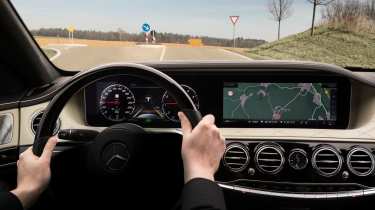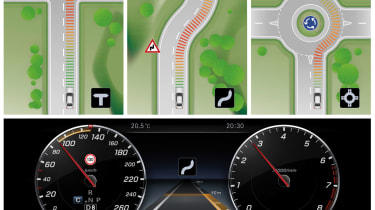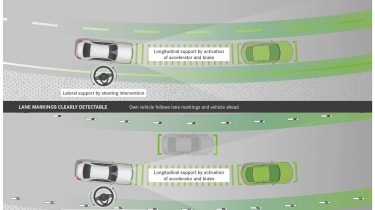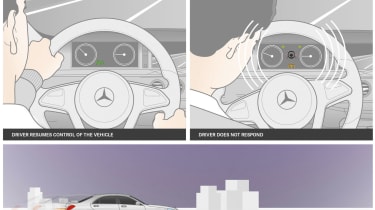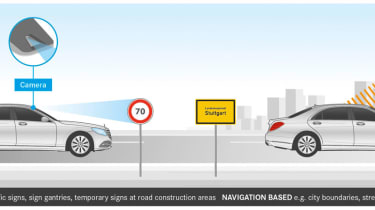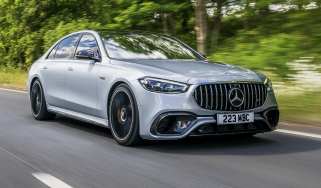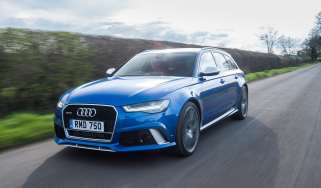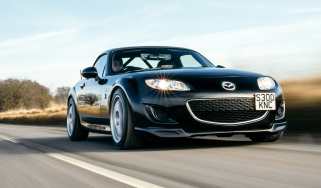New S-class edges closer to becoming fully autonomous
A huge selection of safety systems relying on improved cameras and radar systems mean Merc's big saloon will almost be able to drive itself
Later this year Mercedes’ top of the range saloon will make a further step to becoming fully autonomous. With improved cameras, a better radar system and help from the navigation system drivers of the Mercedes-Benz S-class will benefit from a car that's about as autonomous as they come.
> Read our review of the Mercedes-Benz S-class
A total of 12 systems will turn the S-class into a semi-autonomous car on a wide range of different roads - and not just motorways, either. It will be easy to see which systems have been selected which ones are active at any given time thanks to icons on the car’s screens and in the head-up display. Drivers will be able to control the level of assistance – and, presumably, turn each one off – easily through buttons on the steering wheel.
The dozen systems that make the S-class into a semi-autonomous machine are:
Active Distance Assist DISTRONIC
This is an evolution of Mercedes’ radar cruise control. It maintains an equal distance between the car in front if it’s travelling at a slower speed than the one set by the driver.
The new system also reduces the car’s speed when it knows there is a bend, junction, roundabout or tollbooth ahead. Once safe to do so, it then increases the car’s speed back up to the selected figure.
Combined with Active Steering Assist (see below) the S-class is capable of slowing down and steering sufficiently well without driver involvement that it has the capability to drive autonomously on country roads.
Active Steering Assist
The car’s EPAS system can be controlled by the steering wheel and by Active Steering Assist. It uses the S-class’s camera and radar to identify corners and obstructions and steer around them when safe.
A further safety system called Evasive Steering Assist helps the driver avoid pedestrians that might be in danger and applies extra torque to the steering in the same direction that the driver is steering.
Following vehicles in a tailback
Unlike before, the S-class’s cruise control will remain active for longer than 30 seconds if the car is stationary. It will then pull away and continue to adapt to the traffic.
Active Lane Change Assist
When travelling on a multi-lane road, this system allows the driver to change lanes just by moving the indicator stalk. If it’s safe to move across within 10 seconds of the indicators being activated, the S-class will change into the desired lane.
Active Speed Limit Assist
This system uses Traffic Sign Assist (see below) to read the speed limit of a given road and overrides the Active Distance Assist DISTRONIC and sets the cruise control to that new speed. It also uses the navigation to identify when the car is in a built up area or country road and adapts the S-class’s speed to suit.
Active Emergency Stop Assist
With both Active Distance Assist DISTRONIC and Active Steering Assist switched on, this system stops the car if the driver hasn’t interacted with steering wheel over a certain time period. A warning appears on the dash and a noise is heard to prompt the driver to return their hands to the wheel. The car only stops itself if the driver doesn’t react to the alarms.
Active Brake Assist
This uses the cameras and radar system on the car to detect any potential collisions. If the driver doesn’t react or take action the system first lights up a warning symbol on the dash then, if no further action is taken, an alarm will sound. If the driver still fails to respond, and the obstruction remains, it applies the car’s brakes.
The system also monitors when the driver is braking and if it thinks more force needs to be applied to avoid a collision it will assist and add more pressure.
Active Lane Keeping Assist
When the car unintentionally veers from its lane, this system sends vibrations though the wheel to alert the driver. If it sees the line is a continuous unbroken one then it applies the brakes to one side to steer the vehicle back into its lane. It only intervenes and applies the brakes when the car crosses a broken line if it suspects there’s a potential collision.
Active Blind Spot Assist
If another vehicle is detected in the S-class’s blind spot when the indicators have been activated an alarm sounds. And, at higher speeds, the brakes are applied to one side of the car to steer it away from the other vehicle.
Traffic Sign Assist
Cameras detect speed warning signs then display the limit is displayed in the instrument cluster and on the head-up display. Traffic Sign Assist also uses the car’s location from the navigation and displays the assumed speed limit depending on whether it knows if the car is in a built-up area or on a country road.
The system also detects whether there are zebra crossings on the route, what the weather conditions are (if the wipers are on the car knows it’s raining) and adjusts the speed limit according to the situation.
Car-to-X Communication
Information about traffic and hazardous situations is sent to other cars equipped with Car-to-X. Cars that receive data relay the information to the driver on the map or, if it’s a more urgent, a voice repeats what the hazard is.
Active Parking Assist
As well as helping a driver park into parallel and bay spaces by manoeuvring the car automatically, this system also helps search for parking spots.
When leaving a space it can detect any approaching obstacles and stop the car if it detects a potential crash.
Remote Parking Assist
This system is useful if a parking space is too tight to allow the driver and passengers to exit the S-class once it is parked. The driver can get out of the car before it has been parked and can then complete the manoeuvre via a smartphone. However, the S-class can only move up to 15 metres without a driver behind the wheel.
